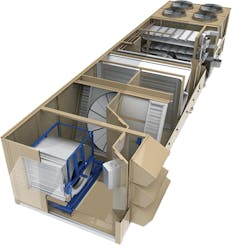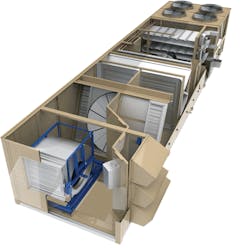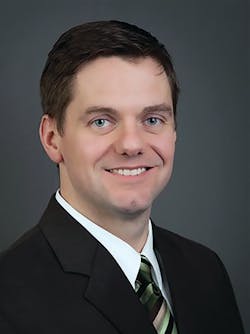Q&A: New Johnson Controls Rooftop Units Designed for Value, Efficiency
Milwaukee, Wisc. – Johnson Controls has reimagined the design features and flexibility of an applied HVAC system into the value and simplicity of a rooftop unit. New, Premier™ 25-50 ton commercial rooftop units from Johnson Controls deliver superior standard efficiency while reducing operational costs over the life of the unit.
Premier includes class-leading standard efficiency models that already comply with stringent Department of Energy (DOE) 2023 energy efficiency standards. Additional options are available for each tonnage to meet the Consortium for Energy Efficiency (CEE) 2019 highest tier ratings. This translates into significant cost-savings over the life of the rooftop unit.
Premier rooftop units streamline the design process with integrated system selection tools, easily accessible building information modeling (BIM) files, improved submittals and simplified specifications. Additional flexibility is provided on high-performance base models through a complete range of factory options, including various airflow path configurations, indoor environmental quality options and modulating options for improved comfort.
Premier rooftop units are Smart Equipment enabled and offer start-up wizards and an array of user-adaptable parameters to help expedite start-up and commissioning. Smart Equipment provides complete control across multiple available rooftop units and seamlessly integrates with interfaces, including zone controllers and other building controls systems such as Verasys®.
— Product news was provided by Johnson Controls
Contracting Business wanted to speak with an expert from Johnson Controls, to help inform contractors on the various ways in which these trends are influencing the design of Johnson Controls’ newest RTU products, the Premier line of rooftop units. We spoke with Kevin Stockton, Product Manager for rooftop units, Johnson Controls.
CB: How have energy regulations brought about new, more efficient RTU Systems?
Kevin Stockton: “The Department of Energy’s 2018 RTU energy regulations, and the new standards coming in 2023, has forced the industry to cope with changes and start to drive towards the future of what efficiency needs to be related to rooftop units.
(Ed.Note: The first phase of these regulations took effect January 1, 2018, and increased the minimum efficiency of commercial rooftop units (RTUs) by approximately 13 percent. The second phase will go into effect on January 1, 2023, and require an additional 15 percent increase in RTU efficiency.) — Product news was provided by Johnson Controls
“ASHRAE Standard 90.1 has continued to drive enhancements for rooftop units, from economizer controls, to the implementation of energy recovery wheels. DOE and ASHRAE have made OEMs react. But at Johnson Controls, we don’t just react. We hope we’re moving the ball forward, and giving our customers great options for efficiency and meeting regulations.”
CB: How do contractor needs impact the RTU market?
KS: “Contractors want to be able to put the unit in place, get it up and running, and get off the job site.
“Using the Johnson Controls Premier RTU products as an example, Johnson Controls has done a lot to help increase the speed at which you can get a unit up and running. We’ve added start up wizards, balancing wizards, and commissioning wizards, which are three features built into our control platform designed to help get a contractor get an RTU up and running.
“We’ve also tied the [newest] RTUs into a ‘map gateway.’ This is a device that allows you to connect the map to a sensor in your building space, and it’s connected to all your rooftops, or all your rooftops are connected up from an Ethernet perspective. At that map, you can go plug it into any one of those devices, pull out your smart phone or tablet, and begin interfacing with all those units. Again, that’s all kind of designed to help ease the installation process and ease the process of servicing units as well.
“From a building owner’s perspective there is a wave coming from various manufacturers that combines the flexibility of a package rooftop system with an economical price. RTUs have always been economical, but traditionally, they’ve kind of lagged behind in terms of features and flexibility. So we’ve added much more flexibility, that maybe traditionally was only seen in a semi-custom rooftop unit, market space, or modular air and other chiller applications.
“And given that flexibility, we’re also trying to drive down the overall cost of installation. That includes using UV lights, which can help an owner from an indoor environmental quality perspective, or HEPA filters, depending on the application. The end user may need to be able to really dial in indoor air quality, and have very clean air come out of its units.”
CB: How is Johnson Controls meeting end-user needs for faster RTU installation and service?
KS: “Before we rolled out the Premier RTUs, and while developing the product, we did do a lot of ‘voice of the customer’ surveys, and met with building owners, engineers, and contractors. Some of their ideas were as simple as just being able to provide additional content to help them understand things, like diagrams to help point out specifically where the gas heat connection is, the location of various different electrical connections, and how it would come into the unit, whether it’s a power coming in from the side of the unit, or whether it’s going into the bottom of the unit.
“Another improvement was to provide documentation to help the crane operators who lift the unit and set it in place. In the next quarter we’re planning to roll out an ‘QR Toolkit.’ it basically relies on a QR code app that is on the unit itself. And that QR code app can be scanned, and then it brings up specific information on that given unit.”
CB: How are smarter buildings and central controls impacting the RTU market?
KS: “The trend toward ‘smarter’ buildings and central controls are helping original equipment manufacturers bring advancements to traditional, less complicated systems, such as rooftop units, for a more attractive first cost.
“Johnson Controls Verasys platform is a configurable, as opposed to a programmable control system, which scales back some of the overall functionality you might have in more complex controls systems. It can save those building owners and those contractors who are traditionally installing simpler thermostat type installations, they can move up to a Verasys control system. In doing so, they have more capabilities and functionalities, from monitoring units, and optimizing control, which you would not have with a traditional thermostat.
“There are still many rooftop installations that are controlled by a thermostat. Systems like Verasys will help make systems as a whole more efficient, and allow owners to interact with the systems to optimize efficiency, and to track potential issues and alarms.”
CB: How are data driven operations impacting RTU development?
KS: “Part of it is definitely related to data on energy use. Another piece we’ve seen goes beyond simply tracking performance, to ensure that your unit is operating as you expect it to be operating. That includes items like fault detection, and diagnostics, and specifically on our larger RTUs, that comes into play, in economizer operations.
“We’ve seen more and more of those requests drive fault detection diagnostics on economizers, to help ensure that the unit is operating, and that the economizer damper is not stuck in the open position, which would bring in hot outside air. Or it’s possibly stuck in the closed position, which would bring in outside air.
“California’s Title 24 has driven some of the development of fault detection diagnostics, and we’ve seen more and more people buying into that as well, especially around the economizer efficiency, which is an important function of packaged rooftop units.”
EDITOR'S NOTE: A previous version of this story identified Premier units as NexusPremier.
About the Author
Terry McIver
Content Director - CB
As director of content for Contracting Business, he produces daily content and feature articles for CB's 38,000 print subscribers and many more Internet visitors. He has written hundreds, if not two or three, pieces of news, features and contractor profile articles for CB's audience of quality HVACR contractors. He can also be found covering HVACR industry events or visiting with manufacturers and contractors. He also has significant experience in trade show planning.


